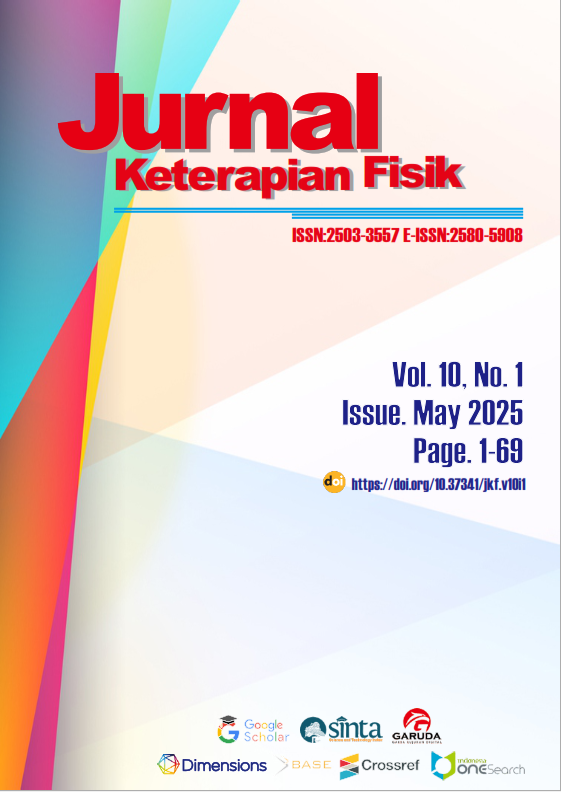Effectiveness of Jin’s 3 Needles and INMAS Acupuncture in Reducing Low Back Pain
Main Article Content
Abstract
Background: Low back pain is one of the musculoskeletal disorders caused by poor body activity. Acupuncture for low back pain can stimulate the body to secrete endorphins which cause the body to become comfortable and relaxed, so that the degree of pain in the low back can be reduced. This study aims to compare the effect of Jin's 3 needles acupuncture therapy with Integrative Neuromuscular Acupoint System (INMAS) on changes in the degree of low back pain.
Methods: This study used the two groups pre and post test design. The sample was 36 research subjects who met the inclusion and exclusion criteria and were selected using a simple random sampling technique, divided into 2 groups, namely the Jin's 3 needles group and the INMAS group. The data were analysed using the Wilcoxon test for changes within groups and the Mann–Whitney test for comparisons between groups.
Results: The acupuncture therapy intervention of the Jin's 3 Needles method and the INMAS method is effective in reducing the degree of low back pain (p-value:<0.001). There is no significant difference between acupuncture therapy interventions Jin's 3 Needles method and INMAS in reducing the degree of low back pain (p value 0.769).
Conclusion: There is an effect of acupuncture therapy Jin's 3 Needles and INMAS on changes in the degree of low back pain and there is no significant difference between the two interventions. Both interventions can be considered as non-pharmacological treatment options for lower back pain.
Article Details
How to Cite
References
Abdullah, I., & Prihatono, A. (2021). Pengaruh akupunktur Jin’ s 3 Needle dalam menurunkan intensitas nyeri penderita nyeri punggung bawah di Balai Kesehatan Tradisional Sehat Harmoni Indonesia Malang. Journal of Islamic Medicine, 5(1), 56–63. https://doi.org/10.18860/jim.v5i1.8972
Bonfiglioli, R., Caraballo-arias, Y., & Salmen-navarro, A. (2022). Epidemiology of work-related musculoskeletal disorders. Current Opinion in Epidemiology and Public Health, 1(1), 18–24. https://doi.org/10.1097/PXH.0000000000000003
Dahlan, S. (2020). Besar sampel dalam penelitian kedokteran dan kesehatan (5th. Ed). Penerbit Salemba Medika.
Dahlan, S. (2021). Statistik untuk kedokteran dan kesehatan (6th Ed.). Epidemiologi Indonesia.
Fracchia, L., Olivero, A. M., Rustichelli, R., & Pedrali, T. (2024). Acupuncture in musculoskeletal pain: analysis of changes in pain perception using the NRS (Numeric Rating Scale). Frontiers in Pain Research, January 1–5. https://doi.org/10.3389/fpain.2023.1294428
Hu, X., Dong, S., Zhang, B., Wang, X., Yin, Y., Liu, C., Yu, J., Wu, X., Xu, F., & Meng, C. (2021). Efficacy of silver needle therapy for the treatment of chronic nonspecific low back pain: A prospective, single-center, randomized, parallel-controlled clinical trial. Trials, 22(1), 1–11. https://doi.org/10.1186/s13063-021-05040-y
Japaries, W., & Nando, A. (2022). Pestle Needle (Chu Zhen) treatment for low-back pain and sciatica. Medical Acupuncture, 34(2), 137–141. https://doi.org/10.1089/acu.2021.0032
Jia, N., Zhang, M., Zhang, H., Ling, R., Liu, Y., Li, G., Yin, Y., & Shao, H. (2022). Prevalence and risk factors analysis for low back pain among occupational groups in key industries of China. BMC Public Health, 22(1493), 1–10. https://doi.org/10.1186/s12889-022-13730-8
Keshavamurthy, Singh, A. K., Buttagat, V., & Divya, B. R. (2023). Exploring the bioenergy pathways affecting the low back pain – A review. Journal of Applied Consciousness Studies, 11(1), 67–76. https://doi.org/10.4103/jacs.jacs_16_22
Lin, J.-G., Kotha, P., & Chen, Y.-H. (2022). Understandings of acupuncture application and mechanisms. Am J Transl Res, 14(3), 1469–1481.
Liu, J., Jin, Y., Feng, X., Huang, H., Chang, S., Xu, H., & Chen, X. (2023). The effects of the sleep three-needle acupuncture technique on acupoint temperature variations in patients with chronic primary insomnia: A research protocol for a randomized controlled trial. Journal of Mechanics in Medicine and Biology, 23(9), 1–10. https://doi.org/10.1142/S0219519423400912
Purwanto, & Wahyudi, J. R. (2021). Differences between effectiveness of Inmas acupuncture and local points in back and shoulder pain. Jurnal Keterapian Fisik, 6(1), 58–64. https://doi.org/10.3734/jkf.v0i0.251
Sudhakaran, P. (2021). Acupuncture for Low-Back Pain. Medical Acupuncture, 33(3), 219–225. https://doi.org/10.1089/acu.2020.1499
Tambuwun, J. H., Malonda, N. S. H., & Kawatu, P. A. T. (2020). Hubungan antara usia dan masa kerja dengan keluhan muskulo-skeletal pada pekerja mebel di Desa Leilem Dua Kecamatan Sonder. Medical Scope Journal. https://doi.org/10.35790/msj.1.2.2020.27201
Zhang, K., Lin, X., Liu, Z., Fu, Y., Wang, L., Zhang, D., Zhang, Q., Zhang, F., Wang, X., & Dong, B. (2024). Therapeutic effects of different acupuncture methods on chronic nonspecific low back pain: A network meta-analysis. Journal of Orthopaedic Surgery and Research, 19(1), 1. https://doi.org/10.1186/s13018-024-05118-8

